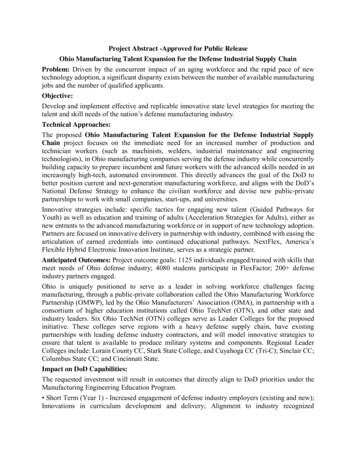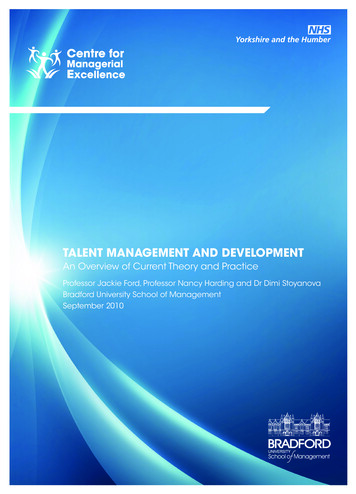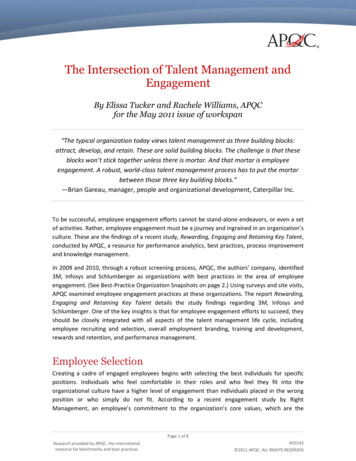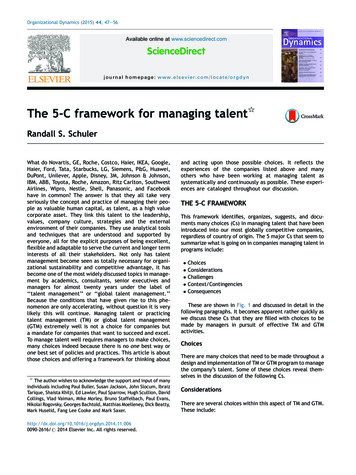
Transcription
Project Abstract -Approved for Public ReleaseOhio Manufacturing Talent Expansion for the Defense Industrial Supply ChainProblem: Driven by the concurrent impact of an aging workforce and the rapid pace of newtechnology adoption, a significant disparity exists between the number of available manufacturingjobs and the number of qualified applicants.Objective:Develop and implement effective and replicable innovative state level strategies for meeting thetalent and skill needs of the nation’s defense manufacturing industry.Technical Approaches:The proposed Ohio Manufacturing Talent Expansion for the Defense Industrial SupplyChain project focuses on the immediate need for an increased number of production andtechnician workers (such as machinists, welders, industrial maintenance and engineeringtechnologists), in Ohio manufacturing companies serving the defense industry while concurrentlybuilding capacity to prepare incumbent and future workers with the advanced skills needed in anincreasingly high-tech, automated environment. This directly advances the goal of the DoD tobetter position current and next-generation manufacturing workforce, and aligns with the DoD’sNational Defense Strategy to enhance the civilian workforce and devise new public-privatepartnerships to work with small companies, start-ups, and universities.Innovative strategies include: specific tactics for engaging new talent (Guided Pathways forYouth) as well as education and training of adults (Acceleration Strategies for Adults), either asnew entrants to the advanced manufacturing workforce or in support of new technology adoption.Partners are focused on innovative delivery in partnership with industry, combined with easing thearticulation of earned credentials into continued educational pathways. NextFlex, America’sFlexible Hybrid Electronic Innovation Institute, serves as a strategic partner.Anticipated Outcomes: Project outcome goals: 1125 individuals engaged/trained with skills thatmeet needs of Ohio defense industry; 4080 students participate in FlexFactor; 200 defenseindustry partners engaged.Ohio is uniquely positioned to serve as a leader in solving workforce challenges facingmanufacturing, through a public-private collaboration called the Ohio Manufacturing WorkforcePartnership (OMWP), led by the Ohio Manufacturers’ Association (OMA), in partnership with aconsortium of higher education institutions called Ohio TechNet (OTN), and other state andindustry leaders. Six Ohio TechNet (OTN) colleges serve as Leader Colleges for the proposedinitiative. These colleges serve regions with a heavy defense supply chain, have existingpartnerships with leading defense industry contractors, and will model innovative strategies toensure that talent is available to produce military systems and components. Regional LeaderColleges include: Lorain County CC, Stark State College, and Cuyahoga CC (Tri-C); Sinclair CC;Columbus State CC; and Cincinnati State.Impact on DoD Capabilities:The requested investment will result in outcomes that directly align to DoD priorities under theManufacturing Engineering Education Program. Short Term (Year 1) - Increased engagement of defense industry employers (existing and new);Innovations in curriculum development and delivery; Alignment to industry recognized
credentials; Expansion of earn and learn opportunities; FlexFactor adoption as a unified talentengagement strategy aligned to needs of defense suppliers. Middle Term (Year 2) – Increased and accelerated enrollment and completion of postsecondarymanufacturing programs; Increased earn and learn opportunities with defense partners;Documentation of innovations in delivery, such as competency-based, micro-credentialing, andindustry-education partnerships supporting them. Long Term (Year 3 and post-grant) - System-wide strategies emerge for dissemination;Continuation of nationally relevant, transferable, and stackable curriculum.
TECHNICAL PROPOSALFOA #N00014-19-S-F006Manufacturing Engineering Education ProgramDepartment of the Navy, Office of Naval ResearchOhio Manufacturing Talent Expansion for the Defense Industrial Supply ChainPrime ApplicantLorain County Community CollegeSub-AwardsCincinnati State Technical and Community CollegeColumbus State Community CollegeCuyahoga Community College (Tri-C)Sinclair Community CollegeStark State CollegeNextFlex Learning ProgramsAdministrative/Business and Technical ContactTerri Burgess SanduDirector, Talent & Business InnovationLorain County Community CollegeTelephone: 440.366.4215Email: tsandu@lorainccc.eduProposed Period of Performance36 months, 09/01/2019 – 08/31/2022Total Proposed Budget 5,000,0001
Table of ContentsTechnical Approach – Overview . 31. Proposed Education/Training Program . 4A. Specific Industry Needs/ Collaborations with Target Industry Partners . 7B. Program-Specific Measures of Participant Outcomes . 8C. Qualified and Experienced Education and Training Personnel . 8D. Continuous Improvement Approach . 92. The Initiatives or Activities to Attract Superior Participants . 9A. Innovation and Projected Effectiveness of the Proposed Project . 11B. Significance of the Impacts on Participants, Target Industries or Communities . 114. Sustainability -Detailed Business Strategy . 125. Realism and Reasonableness in the Proposed Budget . 12Project Director/ Principal Investigator Qualifications . 14Responsibility . 15Reports. 152
Technical Approach – OverviewOhio plays a critical role in the nation’s defense industry as the top supplier to leading aerospaceand defense companies, and plays a vital role in the advancement of new technologies as evidencedby its engagement with a number of Manufacturing Innovation Institutes supported by theDepartment of Defense (DoD), such as Lightweight Innovations for Tomorrow (LIFT), AmericaMakes, NextFlex, and the Advanced Robotics for Manufacturing (ARM) Institute. The proposedOhio Manufacturing Talent Expansion for the Defense Industrial Supply Chain projectfocuses on meeting the immediate need for production and technician workers in Ohiomanufacturing companies serving the defense industry while concurrently building capacity withinboth industry and higher education to prepare incumbent and future workers with the advancedskills needed in an increasingly high-tech environment. With a specific focus on shop-floorcapabilities, this project directly advances the goal of the DoD to better position the current andnext-generation manufacturing workforce. The collaborative effort aligns with the DoD’s NationalDefense Strategy to enhance the civilian workforce and devise new public-private partnerships towork with small companies, start-ups, and universities.Manufacturing is the leading private sector employer in Ohio and the state is expected to seecontinued sector growth over the next ten years. The challenge to ensure that there are enoughqualified technicians to fill these increasingly high-tech manufacturing occupations is driven bythe concurrent impact of an aging workforce and the rapid pace of new technology adoption withinthe fourth industrial revolution (Industry 4.0). Future growth may be constrained by the significantdisparity between the number of available manufacturing jobs and the number of qualifiedapplicants to fill those jobs (OMA, 2019).Ohio is uniquely positioned to serve as a leader in solving this acute workforce challenge, througha public-private collaboration called the Ohio Manufacturing Workforce Partnership (OMWP), ledby the Ohio Manufacturers’ Association (OMA), in partnership with a consortium of highereducation institutions called Ohio TechNet (OTN), and other state and industry leaders. OMA hasspearheaded a movement among Ohio manufacturers, informed by a statewide workforceroadmap, to implement industry-led sector partnerships, facilitating collaboration amongeducation, economic development, workforce development, and industry leaders to addressworkforce gaps in regional labor markets. Colleges throughout Ohio will partner with theseindustry partners to enhance curricula with defense contractors such as Lockheed Martin, GEAviation, Arconic, Siemens, LC Technologies, Southwire and others; and research anddevelopment organizations such as Wright Patterson Airforce Base, NASA Glenn, BattelleMemorial Institute, and the Ohio Manufacturing Institute at The Ohio State University. OMA willassist with statewide dissemination strategies, scaling and sustainability. NextFlex, the FlexibleHybrid Electronic Innovation Institute, serves as a strategic partner.Driven by engagement with an anticipated 200 industry partners, OMWP has establishedambitious, yet attainable goals for this project. Partners are set to train 1,125 adult workers overthree years, with an additional 4,080 high-school students engaged in advanced manufacturingcareer awareness through participation in FlexFactor, a collaborative technology andentrepreneurship program for youth developed by NextFlex. This work will bolster statewidecapacity to recruit and educate skilled technicians throughout the advanced manufacturing sectorto maintain the superiority of the United States Department of Defense.3
1. Proposed Education/Training ProgramSix Ohio TechNet (OTN) partners serve as LeaderColleges for the proposed initiative. LeaderColleges serve regions with a heavy defense supplychain, and have existing partnerships with defenseindustry contractors, as demonstrated in Figure 1.These colleges are: Lorain County CC, Stark StateCollege, and Cuyahoga CC (Tri-C), all in NortheastOhio; Sinclair CC in Dayton/Southwest Ohio;Columbus State CC in Central Ohio; and CincinnatiState in Southwest Ohio. These colleges will modelinnovative strategies to ensure that talent isavailable to produce military systems andcomponents to maintain technological superiorityfor the DoD. This project utilizes regional andstatewide workforce assets to enhance innovationsrelated to (1) Guided Pathways for Youth, and (2) Acceleration Strategies for Adults. CurriculumFocus: Leader Colleges and partners will focus on shop-floor capabilities and middle-skill STEMjobs. As programs are launched in response to Industry 4.0, additional innovation is expected infields such as Industrial Internet of Things, Data Analytics, and Robotics. Guided Pathways forYouth and Acceleration Strategies for Adults both rely on industry adoption of nationally portablecredentials and certificates. Each Leader College will utilize a combination of the shared strategiesin Table 1.Table 1. Innovative Delivery Methods/ Grant StrategiesGuided Pathways for Youth (HS)Acceleration Strategies for Adults FlexFactor Leveraging Military Transfer AssuranceGuides (M-TAGS) Enhanced dual enrollment & CTE Pathways Leveraging Competency-Based Hybrid curriculum designEducation (CBE) Expansion of Earn and Learn Leveraging Prior Learning Assessment Expanding industry partnerships for Expansion of earn and learn programsoutreachindustry Expanded engagement of underrepresented Building/enhancingpartnershipsaudiences into manufacturing pathwaysShared Strategies and AssetsCollege Credit Plus – high school/college dual enrollment program, includes CTE pathwaysFlexFactor - advanced manufacturing career pathway initiative partnering K-12 schools withcommunity colleges and industry partners (developed by NextFlex)Applied Bachelor’s Degrees - offered by some community colleges to create new avenues forpartnering with industry to offer advanced technical trainingOhio Manufacturing Foundations Certificate - industry-supported, state-recognized certificationUniversity Partnerships - numerous articulation agreements between universities and OTNcolleges that provide pathways to bachelor and advanced degrees, including University ofCincinnati, Miami University, University of Akron, Cleveland State University, and The OhioState University including the Ohio Manufacturing Institute4
Each college, with industry input, has identified priority occupations and educational pathwaysthat will complement statewide shared strategies that focus on enhancing defense manufacturing.As part of a coordinated strategy to leverage innovative high school dual enrollment opportunitieswithin Ohio, and as part the Guided Pathway for Youth strategy, all Leader Colleges willimplement iterations of FlexFactor, designed by NextFlex, a Manufacturing USA Institute(explained in Section II). Rapid-skill provision, digital badging/industry-recognized credentials,competency-based education, credit for prior learning, and expansion of earn and learn /apprenticeship are among the innovations Leader Colleges will pursue within the AccelerationStrategies for Adults pillar.Table 2. Ohio TechNet Regional Leader Colleges, Assets, and Defense Industry PartnersNortheast Ohio Region1. Lorain County Community CollegeAssets: Earn and learn innovation (microelectronics, automation), FlexFactor, advanced facilities(microsystems commercialization; digital fabrication; FabLab), MyUniversity (HS dualenrollment to BA), Applied Bachelor’s degree in microelectronics; short-term/ Fast Pathcertification; CBE; active partnerships with America Makes, ARM, LIFT, NextFlex for talentengagement, digital badging, other innovations.Pathways: MEMS, digital fabrication, automation, industrial internet of things, data analyticsDefense Industry Partners: Siemens, Southwire, RP M, Elyria Foundry, NASA GlennGuided Pathways for Youth: Expansion of FlexFactor and development of sustainabilitystrategy; Leverage Ohio Manufacturing Foundations via high school courseworkAcceleration Strategies for Adults: Use CNC Machining/Operator Pathway to develop noncredit to credit pathways with credit for prior learning; Industry-Faculty collaboration to solvechallenge of hands-on learning; Targeted veteran, military and women outreach.2. Cuyahoga Community College (Tri-C)Assets: Early College Early Career partnership with MAGNET (regional MEP); additivemanufacturing curriculum.Pathways: CAD Robotics, Industry 4.0 related pathwaysDefense Industry Partners: Arconic, Swagelok, NASA GlennGuided Pathways for Youth: FlexFactorAcceleration Strategies for Adults: Customize existing programs (Precision MachiningTechnology, Additive Manufacturing, Industrial Welding, Mechatronics, Industrial Maintenance)to meet the training needs and fill open positions of defense industry employers3. Stark State CollegeAssets: Registered Apprenticeship program, Learn to Earn program, Learn to Earn Next LevelPathways: CNC Machining, Welding, Engineering Technologies programs,Defense Industry Partners: Sandia National Laboratories, Lockheed Martin, BWXTechnologies, The Timken CompanyGuided Pathways for Youth: Implement FlexFactor program, expanding reach throughoutproject period and beyond; Leverage Learn to Earn program for K-12 students, which aligns withOhio’s College Credit Plus programAcceleration Strategies for Adults: Leverage Learn to Earn Next Level, specifically designed foradult learners- results in stackable industry-recognized credential; Develop curriculum for a nondestructive testing program, which will provide students with an in-demand manufacturing skillsetappealing to Ohio defense manufacturers; Leverage Prior Learning Assessment options.5
Southwest Ohio Region4. Sinclair Community CollegeAssets: Registered apprenticeships, CBE, accelerated pathways, National UAS Center, NSFNational Center for Supply Chain Automation, NSF Midwest Professionals for LogisticsEngineering Technology Education, Center of Excellence in Cyber Security, New MilitaryAffiliated Students Center and Office of Work Based Learning.Sinclair’s CBE model is leading the state’s development of a competency-based educationnetwork for all colleges and universities across the state.Pathways: Automation & Control Technology, Computer Aided Manufacturing, ElectronicsEngineering Technology, Industrial Engineering Technology, Mechanical EngineeringTechnology, SkillsTrac-Industrial Maintenance, and Supply Chain ManagementDefense Industry Partners: Heroux Devtek, Millat Industries, Air Force Institute of Technologyat Wright-Patterson Air Force Base.Guided Pathways for Youth: FlexFactor, which will work in tandem with College Credit Plusand Tech Prep-- Sinclair is the Tech Prep Regional Center West for the state of Ohio; Youth preapprenticeship programs. Women in STEM K-12 recruitment initiative.Acceleration Strategies for Adults: Develop new curricula on topics such as welding, robotics,and 3D printing to be delivered in accelerated and hybrid modalities to support industry 4.0 andthe defense industrial supply chain. Curriculum will have embedded certifications such as:FANUC Robotics, NIMS ITM, SolidWorks, and Siemens PLC.5. Cincinnati State TCCAssets: Workforce Development Center, Additive Mfg. for Light Weighting Curriculum (LIFT),Faculty mentoring LIFTPathways: Additive Mfg, Industrial Maintenance, Mechatronics, Robotics, CNC MachinistDefense Industry Partners: GE Aviation Additive Power, Rhinstahl, Siemens, Meyer ToolGuided Pathways for Youth: FlexFactor with connection to college / career pathwaysAcceleration Strategies for Adults: Identify, develop and deploy short-term certificate, microcredential, and apprenticeship programs and create opportunities for adult students. Createstackable credentials that link to further certificates and degrees.Central Ohio Region6. Columbus State Community CollegeAssets: Modern Manufacturing Work Study, Collaboration of Midwest Professionals for LogisticsEngineering Technology Education (COMPLETE), Manufacturing Experiential AdvancementReadiness Network (EARN)Pathways: Electronic Engineering, Electro-Mechanical EngineeringDefense Industry Partners: Abbott Laboratories, Allied Mineral Products, Autodesk, Inc.,Battelle Memorial Institute, Guild Associates, Inc.Guided Pathways for Youth: FlexFactor, which will work in tandem with College Credit Plusopportunities; Leverage existing Manufacturing Night recruitment event, and the work being donein NSF ATE project Design Thinking: Additive Manufacturing Summer Institute, to increase therecruitment pipeline of high school students.Acceleration Strategies for Adults: Provide additional evening classes, industry certificationprep; Avenue to apply PLA to certifications; Focus on the Operator/Maintainer program offeredthrough the IST Lab, which serves as an entry to employment and is a bootcamp with flexiblescheduling; upon completion, students enter entry level positions as Maintenance Assistance.6
Statewide Dissemination Strategies: Existing infrastructure will be leveraged to guide and supportstatewide dissemination strategies. Ohio has worked extensively in recent years to build thecapacity of manufacturer-led regional sector partnership, which are forming across Ohio,partnering with local organizations to implement manufacturing workforce solutions. LCCC andLeader Colleges have been significant partners in these efforts, through the Ohio TechNetconsortium and related partnership with the Ohio Manufacturers’ Association (OMA). OMA hascommitted to making Ohio the recognized national leader in manufacturing talent development.Three committees (Leadership, Intermediary, State Agency) led by OMA guide and inform thiswork. Additionally, Ohio's community college system has created the Ohio Workforce League, anew statewide workforce team that offers an additional vehicle for statewide dissemination.Specific statewide strategies under this project include 1. Host webinars and leverage in persongatherings to engage employers throughout the state; 2. Develop an automation career pathwayand curriculum toolkit customizable for regional variation; 3. Provide professional development /certification resources to faculty/instructors throughout Ohio based on industry priorities; and4. Summarize impact of project strategies and work with State partners to advancerecommendations to policy makers that scale and sustain effective innovations and strategies.A. Specific Industry Needs/ Collaborations with Target Industry PartnersManufacturing is the leading private sector employer in Ohio, accounting for 700,000 jobs totalingover 40 billion in annual wages. The manufacturing industry comprises nearly 17% of Ohio’sGross Domestic Product, with over 50 billion in exported products sent to 213 countries andterritories in 2018 (OMA, 2019). Since 2013, Ohio has consistently ranked second in the nationfor new manufacturing sites, gaining an average of 512 new manufacturing sites each year (SiteSelection, 2018). Ohio’s robust manufacturing industry has established the state as a hub ofaerospace and defense activity. Ohio is home to several key economic forces that support thedefense industry, including Wright Patterson Air Force Base, the world’s largest military researchand development center and Ohio’s largest single site employer (Jobs Ohio, 2018). Ohio is the topsupplier for Boeing, which has at least 375 suppliers in the state that support 400,000 jobs.(Salomone, 2017). In addition, NASA’s John H. Glenn Research Center in Northeast Ohio is asignificant economic development engine and job generator for the state of Ohio, generating over 700 million annually in economic activity and supporting over 7,000 jobs (CSU, 2017).Ohio’s manufacturing industry is more productive and efficient than ever, and the role of skilledworkers is vital. Skilled and re-skilled technicians are in high demand in Ohio’s advancedmanufacturing industry. The proposed project focuses on production level occupational pathwaysthat rely on adaptive, technical, and automation-era skillsets. Within these pathways, Industry 4.0skillsets and critical manufacturing competencies will be targeted in curricula enhancements andwork-based training programs. The table below lists the occupations and their respective demand,together representing over 500,000 jobs and 48,000 annual openings in Ohio.Table 3: Labor Market Demand, OhioPathwaysOccupations2016JobsEntry-Level: CNC Machine Operators; Machinists85,381Middle-Skilled: CNC Programmers; Tool and Die9,853Higher Skilled: Industrial Prod. Manager; Mechanical Engineer 25,934AnnualOpenings8,2909001,903AverageWage 17.97 24.50 40.737
Entry-Level: Metal Fab/Fitters; Production WorkersMiddle-Skilled: Supervisors of Production WorkersHigher Skilled: Industrial EngineersEntry-Level: Welders and SettersMiddle-Skilled: Welding InspectorsHigher Skilled: Materials Engineer; Welding SupervisorsEntry-Level: Ind. Machining, Mechatronics, Crane OperatorsMiddle-Skilled: Mech Drafters; Eng. Tech.; Elec. InstallHigher Skilled: Mechatronics/Robotics Eng; Electrical ,5151,231 15.66 28.16 38.24 18.49 18.11 28.87 20.50 26.68 41.85B. Program-Specific Measures of Participant OutcomesWith the support of an external program evaluator, a uniform data collection and reporting systemwill be implemented across all sites and organizations. Leader Colleges will measure youth andadult participants (disaggregated by gender, race, and ethnicity), earned certifications, degrees andindustry-recognized credentials, work-based learning experiences, and articulations/transfer tobachelor/advanced degrees. Employer input on the success or impact of this initiative will begathered by survey and via regional advisory councils.Table 4. Program Participant OutcomesYouthAdultIndustryParticipants Participants . 1 750235174Yr. 2 1475410285Yr. 3 1955480348Total ree or Articulated toCredential 4-yearObtained PostsecondaryPartner481079132071533438C. Qualified and Experienced Education and Training PersonnelThe overall project will be led by Terri Burgess Sandu, Director of Talent and Business Innovationat Lorain County Community College. Ms. Sandu’s professional qualifications are listed in detailin the Qualifications section; the overall management approach and organizational chart can befound in the Management Approach section. Leader Colleges are members of Ohio TechNet, aconsortium of education and training institutions promoting efficiency and creativity throughcoordination of higher education’s efforts to support the workforce needs of manufacturers. Theactivities of participating Leader Colleges will be led by their respective appointed personnel.These individuals are listed in Table 5 and their resumes are attached. NextFlex serves as a keypartner both for implementation of FlexFactor and national perspective on needs/trends in supportof DoD manufacturing priorities.Table 5. Key Team MembersOrganization Institutional Project ManagersLorain County Terri Burgess Sandu, ProjectCCDirector; B Gosky, Ohio TechNetManager; A Schweppe, BusinessRoleLead Applicant / Statewide projectmanagement8
Lorain CountyCCCuyahoga CC(Tri-C)Stark StateCollegeSinclair CCCincinnatiState TCCColumbusState CCNextFlexLearningProgramsEngagement; M Matthews,communications, datamanagementDeanna Strauss-Hersko,FlexFactor Program ManagerAlethea Ganaway, ProgramManager, 3D Additive MfgDon M. Ball, Ed.D.Dean, Engineering TechnologiesAnthony Ponder, Dean, Divisionof Science, Math, and EngineeringAmy Waldbillig, Vice PresidentWorkforce DevelopmentScott Wegeng, Director, EmployerEngagemt & ExperientialLearningBrynt Parmeter, Director ofWorkforce Development,Education, & TrainingStatewideTBD through procurement processDissemination,Scaling andSustainabilityStrategiesLeader College (implementation)Leader CollegeLeader CollegeLeader CollegeLeader CollegeLeader CollegeStatewide FlexFactor adoptionAdvisor on national defensemanufacturing talent prioritiesEngage employers throughout the stateDisseminate materials that supportreplication and sustainabilityAutomation career pathwayStatewide professional developmentD. Continuous Improvement ApproachProject partners will utilize a continuous improvement approach that aligns with the DoD’sContinuous Process Improvement (CPI) Transformation Guidebook. Working with anindependent evaluator, senior personnel will establish processes, templates, and timeframes fordata collection and convening, as well as methods for reflection and distribution. Planning,analysis, and goal alignment will be central to the process. Steps include:1) Ecosystem alignment- Convene Leader Colleges, high school and industry partners to plan the integration of FlexFactorinto existing curricula and pathways; 2) Partner onboarding- Confirm roles, responsibilities, andworkflows with each partnering organization; 3) Toolkit for Project Management- Provide toolkitfor Program Managers from each Leader College to ensure consistent data collection, timeframes,and curricula delivery; 4) Deliver the Program Strategies. Initiate the program, deliver content tostudents; 5) Measuring the program- Utilize the uniform measurement system to benchmark andassess progress relative to specific goals and objectives, and budgeted activities. An externalprogram evaluator will support the deployment of measurement systems and tools across allLeader Colleges; 6) Impact Sharing- Disseminate the results of the program through the statewideinfrastructure.2. The Initiatives or Activities to Attract Superior ParticipantsThis proposal integrates initiatives for veterans, women, minorities and other priority orunderrepresented audiences, both adults and youth, including:9
Table 6: Strategies to Increase Access for Under-represented PopulationsPopulation Initiatives and StrategiesEngagement of veterans through connections with VA hospitals, veterans’programs, and veterans’ scholarship programsMilitary Transfer Assurance Guides (MTAGs) provide a statewide guarantee thatcertain types of military training, experience, and/or coursework align to existingcollege and university courses and will be awarded appropriate credit.Veterans/National Association of Manufacturers will provide technical assistance drawingMilitaryon their Heroes MAKE America program with special focus on service membersPopulationexiting the service from Wright-Patterson Air Force Base (Dayton, OH).Each Leader College has a variety of recognized high-quality programs designedto be military friendly and offer specific services for veterans. Sinclair, forexample, is located within 20 miles of Wright-Patterson Air Force Base andserves an estimated 3,500 veterans and active service members annually.Women’s outreach initiatives including engagement with a national impactcommunity hosted by SkillsCommons.org called WISE Pathways, and a statelevel women’s outreach initiative to be embarked on in concert with the OMWP,leveraging MakingOhio.comWomenLeader Colleges target women through marketing and recruitment materials thathighlights the work of female staff members and events focused on attra
Aviation, Arconic, Siemens, LC Technologies, Southwire and others; and research and development organizations such as Wright Patterson Airforce Base, NASA Glenn, Battelle Memorial Institute, and the Ohio Manufacturing Institute at The Ohio State University. OMA will assist with statewide dissemination strategies, scaling and sustainability.











